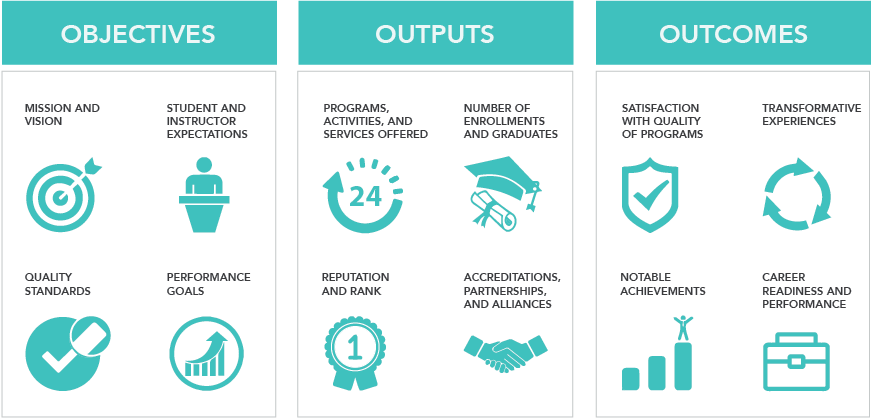With the amount of hype surrounding efforts to improve education outcomes, it’s easy to get the impression that the meaning of this term, “outcomes,” is implicit. It is not. “Outcomes” may be one of the most elusive terms uttered in education circles today, seriously stalling efforts to propel this much needed imperative forward.
Much of the confusion, we find, is due simply to the fact that outcomes are easily conflated with two complementary terms, objectives and outputs, which are not the same thing.
Figure 1. Defining Outcomes
 Click to enlarge image
Outcomes, for instance, are:
Click to enlarge image
Outcomes, for instance, are:
 Click to enlarge image
Outcomes, for instance, are:
Click to enlarge image
Outcomes, for instance, are:
- More than aspirational indicators of student learning. Your mission and vision describe what you aspire to do as an institution, but not what you do. In the same way, learning objectives describe what is expected of students and instructors in a course or program. They are not the actual outcomes of this experience. As critical measures of an institution’s ability to guide student learning, objectives help produce outcomes, but themselves are not outcomes.
- Not descriptions of what your institution does or has achieved. Outputs may include programs, activities, and services offered, as well as the number of graduates in a particular program, rankings, accreditations, or accolades. As critical measures of an institution’s ability to measure quality and progress, outputs are helpful indicators of outcomes, but themselves are also not outcomes.
- Experiential measures of quality and impact.Outcomes are about what happens to students as a result of objectives and outputs. They convey students’ overall satisfaction with a course or program, transformative experiences gained, notable achievements, and tangible indicators of career readiness and improved performance. Outcomes also convey intellectual and emotional connections with your brand and program offerings. They provide a roadmap to help learners make sense of not only who you are and what you do, but also whom you serve, with what success, and to what end.
- Mine social media. An obvious source of outcomes information is social data streams. LinkedIn, for instance, offers interesting insight into what students, their colleagues, and employers think about your programs, as well as job placement rates and competencies (based on endorsements) they may have developed through your programs. Facebook and Twitter are replete with value statements that offer a unique glimpse into what your students say about your programs online and their overall satisfaction, as well as professional and social networks they may be a part of, which help gauge career readiness and performance. All of this data is either available free of charge or, when mined more comprehensively, at a modest cost compared to the insurmountable value these sources will add to your organization.
- Collect data through strategic bilateral partnerships. Another source of outcomes data is partnerships with data sharing organizations. Participation in the National Student Clearinghouse, for instance, is a fantastic first step. Other sources include employer networks and professional organizations. Broader data collection efforts, such as the Common Education Data Standards (CEDS) and the P20 Education Standards Council (PESC), are actively seeking new partners to help bolster the size and scope of their data sets. Participation in these types of networks will help support a coherent approach to data exchange, frameworks for articulation, and secure and transparent processes for communicating data across multiple platforms.
- Curate data with the right tools. With a comprehensive process in place, ensure that you have the systems and infrastructure to store, analyze, and report your data clearly and effectively, both internally and to external stakeholders (including prospective students). Companies, such as IBM, SAP, Microsoft, and Oracle offer numerous solutions to help facilitate this process. Each has a standards-based process for reporting and data exchange, robust analytics, and visualization tools, as well as product advising and technical support.

